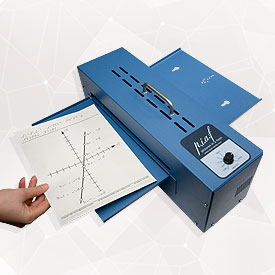At Wichita State University, we have been struggling to provide effective tactile graphics for students with visual disabilities for some time now.
For years, we have been making do with what we could produce using a braille embosser — most of the embossers on the market have the ability to create simple diagrams that are tactile with a pattern of dots. This was always challenging work, because the dots created by the embosser damage the paper — and if they’re close enough together they can create tears. Trying to balance the need for dots to be close together and the need to preserve the integrity of the paper — especially paper that will be touched to be understood — was a tricky balancing act that often took a lot of trial and error.
We did make use of other solutions — Tactipad, for example, to free-hand draw graphics for students. The tactipad diagrams have some advantages over embossed diagrams, but the solution isn’t scalable or reusable, and the diagrams were only be as good as the person drawing them can make them.
The need to create images (rather than text descriptions) is critical in the cases we are working on, with a student who is taking upper division STEM classes — biology classes with hundreds of diagrams and pictures to process in a given semester.
It was at this point that our disability services team discovered a product called Picture in a Flash, and scheduled a demo.

The Picture in a Flash device uses “capsule paper.” A diagram can be printed onto the paper using a standard printer (it must be black ink) and then the capsule paper version is passed through the machine, which heats the paper, and the areas where the paper has been printed on in black swell to create ridges.
We’ve taken to calling our PIAF the “Easy-Bake Oven.” It’s an excellent way to create a graphic which can have much more texture and variability than one created by an embosser. It’s far less loud than most embossers, too.
The primary difficulty with a PIAF device is the capsule paper supply. We use mostly 11×11.5 capsule paper, since the embosser paper we use is also 11×11.5, and that means the two go together in our binders fairly neatly. The capsule paper at that size costs roughly $1.90/sheet. So, while the PIAF device itself is relatively inexpensive (roughly $1,400), the ongoing expense of the capsule paper may be a challenge.
Because the PIAF works simply on black ink on the capsule paper, it’s also possible to draw diagrams by hand, using a provided marker, and then run the sheet through the device. This allows for some creative, inventive uses in class. In one case, an instructor teaching a biology class with a blind student asked students to take turns drawing the cells they viewed through a microscope, then running the paper through a PIAF device in the lab so the blind student could feel the student’s diagram.
Interpretation is Necessary
In most cases, as the designers working on the diagrams that will be printed using the PIAF process, they will not be able to recreate everything that is in the picture they are converting.
Depending upon the original image, there may be colors and shading that convey information, details that are too fine to make perceivable to a tactile user, and a variety of other things. These represent choices that the designer needs to make, and there are major risks that come with that sort of choice.
Unlike most other forms of accommodation that may be provided, this sort of interpretation can have a dramatic impact on the information that a student is given. The risk of inadvertently making a choice that removes information that is actually critical to the student’s understanding of the diagram — or worse, removing information over which the student will be assessed — is too great to be left to chance. The team of designers must work hand in hand with active faculty to make sure they’re making the right choices.
Without that sort of interaction and engagement with the faculty, every step of the way, it’s a certainty that choices will be made that have a profound negative impact on the student’s opportunity to learn. However, that level of engagement takes more time that simply producing a single draft of a graphic and moving on to the next one — time from both the faculty member and the designers. There is no substitute for early, deep engagement with the course instructors.
There are a few other swell-paper/capsule paper devices on the market at the moment, and I’m sure there will be more soon. The PIAF device has proven to be an invaluable addition to our collection of tools — the expense of the swell paper makes it most efficient to produce text with an embosser and images with the PIAF, for example, but I would not want to continue our institutional efforts to provide quality STEM education to blind students without a tool like the PIAF.


